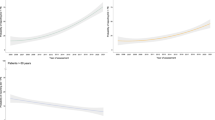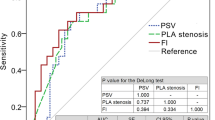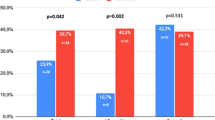Abstract
Peyronie’s disease results in curvature of the penis which may cause difficulty with penetrative intercourse. The diagnosis of Peyronie’s disease is easily obtained through history and physical examination alone, but the severity of erectile dysfunction relies on patient history and use of validated questionnaires. However, erectile dysfunction questionnaires were not validated in the Peyronie’s disease population and may not be a reliable assessment. Penile Doppler ultrasound is a noninvasive tool that assesses vascular function. We hypothesized that penile Doppler ultrasound will be discordant with International Index of Erectile Function (IIEF) results in men with Peyronie’s disease and erectile dysfunction. In this cross-sectional study, we reviewed a prospectively collected database of men with Peyronie’s disease. In total, 108 men had questionnaire and ultrasound data. Of them, 87 had erectile dysfunction based on IIEF-EF or IIEF-5 (SHIM). However, 48 (55%) of those men had normal vascular parameters. Interestingly, among a subgroup of 33 men with severe erectile dysfunction on IIEF-EF or IIEF-5, 20 (61%) had normal vascular parameters. Our study demonstrates significant discordance between questionnaires and penile Doppler ultrasound. Therefore, ultrasound may be a useful tool in the workup of men with Peyronie’s disease and erectile dysfunction.
This is a preview of subscription content, access via your institution
Access options
Subscribe to this journal
Receive 8 print issues and online access
$259.00 per year
only $32.38 per issue
Buy this article
- Purchase on Springer Link
- Instant access to full article PDF
Prices may be subject to local taxes which are calculated during checkout
Similar content being viewed by others
References
Mulhall JP, Creech SD, Boorjian SA, Ghaly S, Kim ED, Moty A, et al. Subjective and objective analysis of the prevalence of Peyronie’s disease in a population of men presenting for prostate cancer screening. J Urol. 2004;171:2350–3.
Schwarzer U, Sommer F, Klotz T, Braun M, Reifenrath B, Engelmann U. The prevalence of Peyronie’s disease: results of a large survey. BJU Int. 2001;88:727–30.
Terrier JE, Nelson CJ. Psychological aspects of Peyronie’s disease. Transl Androl Urol. 2016;5:290–5.
Kalokairinou K, Konstantinidis C, Domazou M, Kalogeropoulos T, Kosmidis P, Gekas AUS. Imaging in Peyronie’s disease. J Clin Imaging Sci. 2012;2:63.
Wymer K, Ziegelmann M, Savage J, Kohler T, Trost L. Plaque calcification: an important predictor of collagenase clostridium histolyticum treatment outcomes for men with Peyronie’s disease. Urology 2018;119:109–14.
Nehra A, Alterowitz R, Culkin DJ, Faraday MM, Hakim LS, Heidelbaugh JJ, et al. Peyronie’s disease: AUA guideline. J Urol. 2015;194:745–53.
Hatzimouratidis K, Eardley I, Giuliano F, Hatzichristou D, Moncada I, Salonia A, et al. EAU guidelines on penile curvature. Eur Urol. 2012;62:543–52.
Lobo JR, Nehra A. Clinical evaluation of erectile dysfunction in the era of PDE-5 inhibitors. Urol Clin North Am. 2005;32:447–55.
Rosen RC, Cappelleri JC, Smith MD, Lipsky J, Pena BM. Development and evaluation of an abridged, 5-item version of the International Index of Erectile Function (IIEF-5) as a diagnostic tool for erectile dysfunction. Int J Impot Res. 1999;11:319–26.
Rosen RC, Riley A, Wagner G, Osterloh IH, Kirkpatrick J, Mishra A. The international index of erectile function (IIEF): a multidimensional scale for assessment of erectile dysfunction. Urology 1997;49:822–30.
Kassouf W, Carrier S. A comparison of the International Index of Erectile Function and erectile dysfunction studies. BJU Int. 2003;91:667–9.
Serefoglu EC, Smith TM, Kaufman GJ, Liu G, Yafi FA, Hellstrom WJG. Factors associated with erectile dysfunction and the Peyronie’s disease questionnaire in patients with Peyronie disease. Urology 2017;107:155–60.
Neijenhuijs KI, Holtmaat K, Aaronson NK, Holzner B, Terwee CB, Cuijpers P, et al. The International Index of Erectile Function (IIEF)—a systematic review of measurement properties. J Sex Med. 2019;16:1078–91.
Hellstrom WJ, Feldman R, Rosen RC, Smith T, Kaufman G, Tursi J. Bother and distress associated with Peyronie’s disease: validation of the Peyronie’s disease questionnaire. J Urol. 2013;190:627–34.
Acknowledgements
We thank everyone involved in the project that helped see it through from start to finish.
Author information
Authors and Affiliations
Corresponding author
Ethics declarations
Conflict of interest
The authors declare no competing interests.
Additional information
Publisher’s note Springer Nature remains neutral with regard to jurisdictional claims in published maps and institutional affiliations.
Rights and permissions
About this article
Cite this article
Masterson, T.A., Efimenko, I.V., Nackeeran, S. et al. Discordant erectile function assessment between validated questionnaire scores and penile Doppler ultrasound in Peyronie’s disease. Int J Impot Res 34, 452–455 (2022). https://doi.org/10.1038/s41443-021-00416-9
Received:
Revised:
Accepted:
Published:
Issue Date:
DOI: https://doi.org/10.1038/s41443-021-00416-9



